Random Prog Review
For a change, let's pick out a single issue and see what we can learn from it.
I give you...
Prog 862

Before we begin, some background context. 2000 A.D. in the early 90s was perhaps reaching the end of its 'seriously hip' phase. A few years earlier it became fashionable to read and talk about comics for adults, which apparently was a novelty (frankly, I've always thought comics were for people of any age, but hey ho). 2000 A.D. had been part of that, mostly because it featured writers and artists who didn't dumb down their stories the way that overt children's comics often did. This was in part due to the second generation of creators to work on the comic, who were becoming old hands by 1993, and most were on the verge of making it big in the USA. Despite the presence of Grant Morrison, Garth Ennis, Dermot Power, Chris Weston et al, I suspect that 2000 AD was still seen by and large as a children's comic, as it certainly had been when it began in 1977.
Anyway, by the time it was 1993, this child/adult readership thing was becoming a little weird. Prog 862 came along just a couple of months after the still-famous 'Summer Offensive' took place - an 8-Prog experiment in which Morrison with some help from Mark Millar took over as editors of 2000 AD, seemingly with a mission statement of making the comic ultra-hip. I might attempt to dissect that experiment some time in the future. Extra context: I was 15 when I first read this Prog.
Hangovers from the Offensive were evident in Prog 862's first strip, Judge Dredd: Book of the Dead (part 4)
Written by Morrison and Millar, painted art by Power. (Lettered, curiously, by John Aldrich - not Dredd stalwart Tom Frame. Was Frame just on holiday, or was he making a statement about quality?) This story was and remains pretty poor. Dredd is visiting the Judges in Luxor, the Egyptian Mega-City. An evil undead monster fights him. That's it, but it's still an 8-episode mini-epic. It's actually a pretty good comic for displaying the level of understanding that these two writers had for the character and world of Dredd. Basically, that he is extrememly hard, and extremely unsympathetic. And frankly, that's not good enough. I can see that they were trying to write crowd-pleasing stuff by showing Dredd sneering a lot, coming up with one-liners and hurting people, but it's relentless, and all too often not very funny. (they did get the comedy hardness right every now and then, so it wasn't all bad) Now, Dredd has always functioned as a satire about heavy-handed policing, which I'm sure M&M enjoyed playing up, but I can't say I remember 1993 as being a bad time for civil rights in the UK, especially compared to today. Ultimately, this era of Dredd is memorable for the story and the art; the former for being so bad, the latter for being disproportionately good.
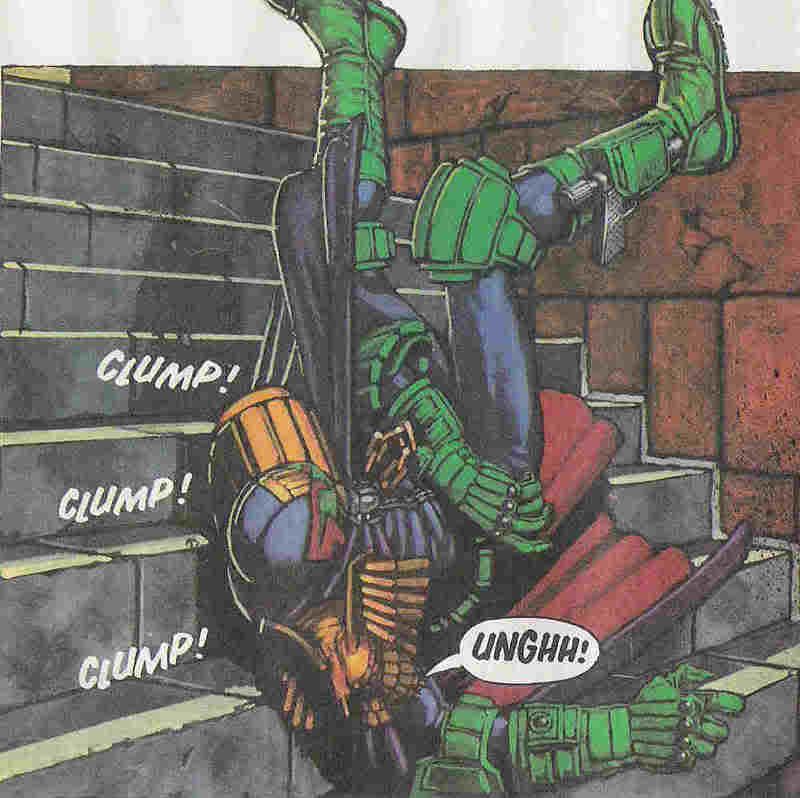 Back to the review. Dredd goes on a tour of Luxor's Resyk facility, watches the recently murdered chief judge get mummified, then falls down the stairs. Great art, and in fact this episode has some fun moments, but overall, not the stuff of legend.
Back to the review. Dredd goes on a tour of Luxor's Resyk facility, watches the recently murdered chief judge get mummified, then falls down the stairs. Great art, and in fact this episode has some fun moments, but overall, not the stuff of legend.
In honour of Dave Campbell's excellent 'Long Box' blog, I will from time to time present my wn 2000 AD 'the pain' awards. But only when a series, episode or panel really deserve it. Like 'Book of the Dead'.
Verdict:
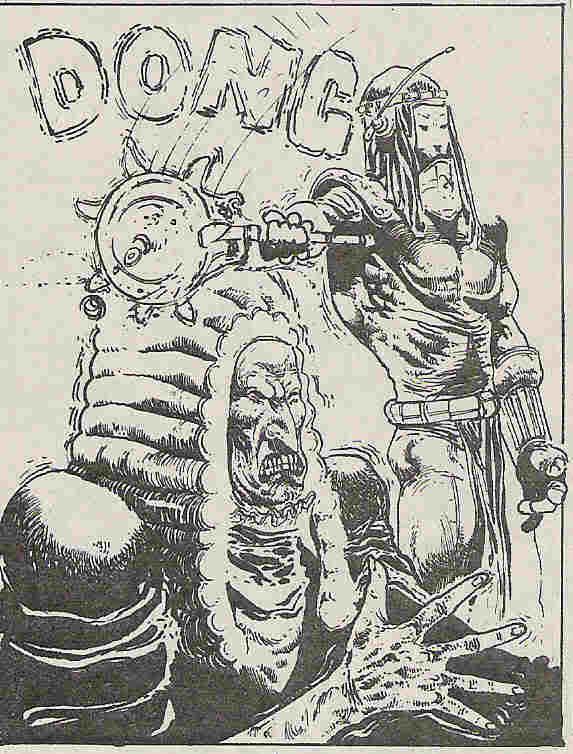
Tharg's Future Shocks: A Kind of Hush
Written by Peter Hogan, drawn by John Haward
Three pages (often a decent Shock doesn't need the full five), a simple story, and essentially harmless. One of those, 'oh, yes, clever idea' ones, not one to blow you away. Haward draws in a nicely detailed style, but it feels very childish next to the painted Power. More on Hogan later...
Verdict: >shrug<>
Mean Arena episode 11
Written by Alan McKenzie drawn by Anthony Williams. That's to say, you can recognize McKenzie's style, but it seems to me that he was trying to copy Mark Millar. Professional jealousy, perhaps? Millar may not be fondly remembered these days, but he was given a lot of work by Tharg at one point, so he must have been doing something right. I wonder if McKenzie thought he would try the same thing as Millar, only do it right. So, instead of taking an old favourite 2000 AD character and making them ultra-violent and ultra-stupid (as Millar did with my beloved Sam Slade), he would take an old not-so favourite series, but give it a new set-up and new characters. And then make them ultra-violent and ultra-silly (actually a bit like Mike Fleischer did with Harlem Heroes, come to think of it).
Basically, Mean Arena is a bit rubbish. Future Sports stories are tricky, and reducing them to a series of fight scenes isn't the answer. Nor is giving them a bland hero figure.
The Mean Arena reboot is interesting from a social history point of view, in that it reads and is drawn remarkably like a classic British children's comic. It sums up nicely the desire to attract new young readers who might be a bit overwhelmed by Power's Dredd, or scared by Chris Weston. Yet by making the story a re-vamp of a strip from the early 80s it's surely also trying to appeal to older readers. Weird. That said, I remember enjoying it at the time, not least because it felt accessible, unlike the recent spate of Morrison pretensions. But time has not been kind to the series, especially since Williams has since improved as an artist. Sure, he's plaenty fun and dynamic here, but it's a bit simplistic compared to his deeply atmospheric VCs work.
This penultimate episode sees the 'super-brawl' in mid-flow; basically, all the characters are smacking the stomm out of each other. In the background, one media company is taking over another medai company (why oh why are all 2000 AD future sports serieses about manager and media shenanigans?).
Verdict: this scene of some loser fallinf foul of a booby trap from epsiode 11 functions nicely as a built-in 'the pain' image:
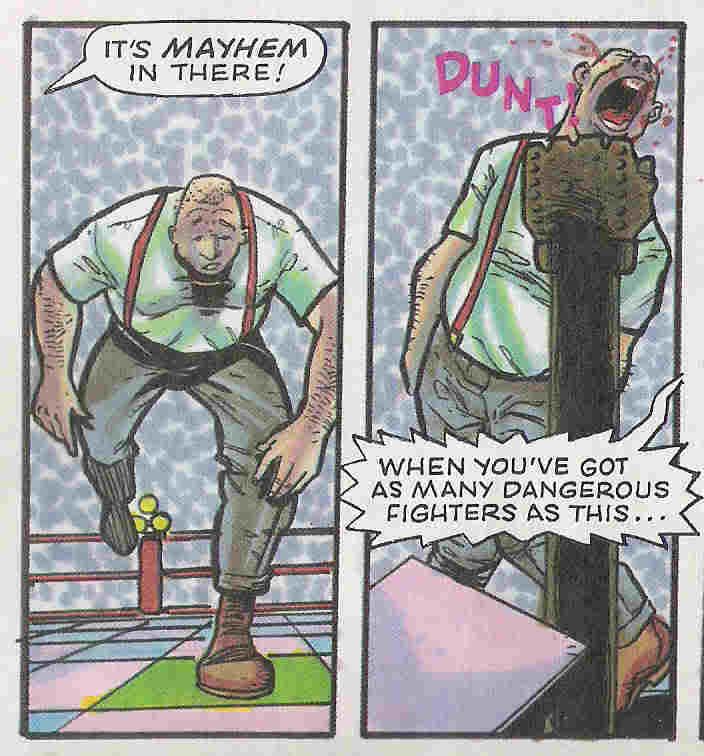 (no, not the text, the idiot being smacked in the chin)
(no, not the text, the idiot being smacked in the chin)
Luckily, the quality takes a leap next, with Canon Fodder episode 2
Written by Mark Millar, loving drawn by Chris Weston. Easily the best thing Millar ever did for the comic, although without Weston's way-out imagination and downright nastiness, it wouldn't stick in the mind nearly so much. We learn in this episode that the series is set in the time of Judgement. All the dead have risen, and are awaiting God's final verdict. Except God never shows up, and all those people are left with a massive overpopulation problem. Inexplicably, the Victorian era dead end up in charge, and in order to keep the people in check, not to mention reverential, a 'priest patrol' has been set up. Canon Fodder is the Judge Dredd of the priest patrol. For what it's worth, he seems to be Church of England.
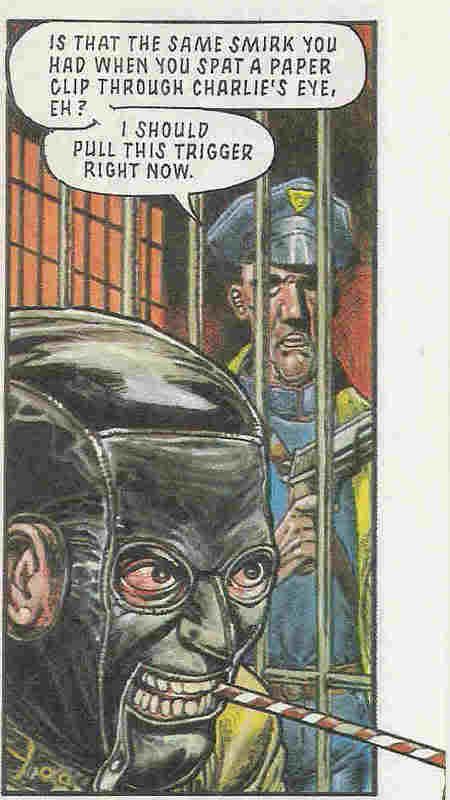
We also meet Mycroft Holmes, older and nasty brother of Sherlock, whom the Canon recruits to aid in his quest. To be sure, the trademark MIllar silliness and inexplicable violence is still present, but the overall concept and characters lift the tale.
Verdict: Worthy of a reprint
Strontium Dogs: The Darkest Star episode 8
Written by Garth Ennis, drawn by Nigel Dobbyn
In which Johnny Alpha is killed for the second time. But, you know, it works, and it remains a genuinely poignant moment for me. Although I have to admit that back when I was 15 I was secretly hoping that they'd resurrect the man. It's best they didn't really.
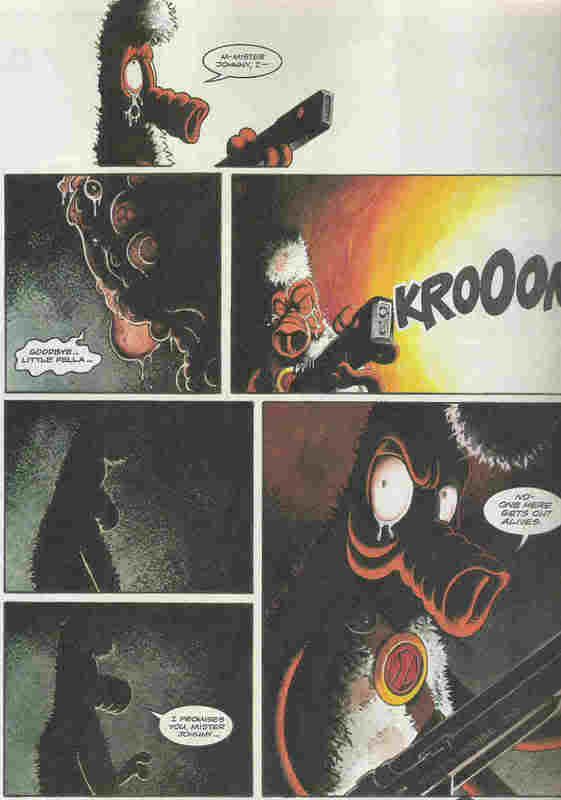 Ennis really went in at the deep end in 2000 AD, taking over from the mighty Wagner on Dredd, Chopper and Strontium Dog(s). He's good, but in these cases not as good as big John W. I think perhaps his humour was a bit too broad in comparison, and, not unlike Millar, his violence was a bit too over the top at times. Still, his efforts with Feral were decent enough, especially with the right artist (i.e. Steve Pugh, not Dobbyn). The Darkest Star suffers from being a bit too much of a continuity piece, trying to piece together the aftermath of 'the Final Solution'. If Alpha had been a US superhero, it would fit right in...
Ennis really went in at the deep end in 2000 AD, taking over from the mighty Wagner on Dredd, Chopper and Strontium Dog(s). He's good, but in these cases not as good as big John W. I think perhaps his humour was a bit too broad in comparison, and, not unlike Millar, his violence was a bit too over the top at times. Still, his efforts with Feral were decent enough, especially with the right artist (i.e. Steve Pugh, not Dobbyn). The Darkest Star suffers from being a bit too much of a continuity piece, trying to piece together the aftermath of 'the Final Solution'. If Alpha had been a US superhero, it would fit right in...
In the end, there are fun moments, and Dobbyn has a great way with emotions, even if his art is just too friendly to draw a mean Feral, let alone a tribe of evil necromancers.
Verdict: solid
Finally, episode 3 of Timehouse
Written by Peter Hogan, lovingly drawn by Tim Bollard
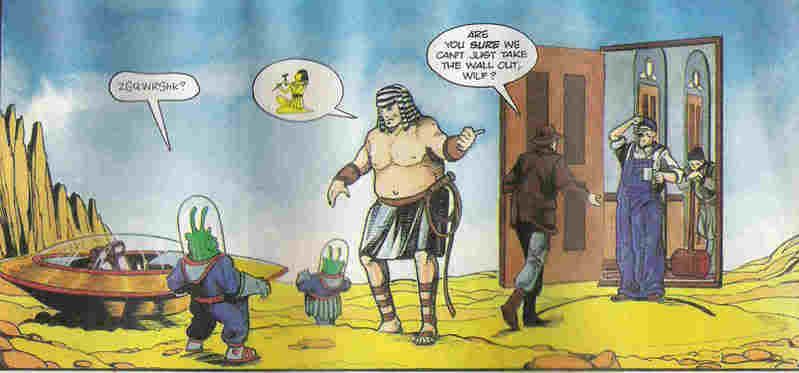 Just look at that. Beautiful, no? Well, I like it, and was sad not to see Tim Bollard outlast Timehouse, which enjoyed just two outings. It is perhaps the single least congruous series to appear in 2000 AD. Clearly something that would have been at home in a Sci-Fi comic aimed at younger, less violent children (would that such a comic existed), it was nevertheless for me a breath of fresh air in the comic. Given all the extreme hardness and casual murder prevalent in most strips for so long, it felt right to me to be able to read the harmless and mildly hapless misadventures of the Time Family. Not unlike a Carl Barks Donald Duck story in many ways - i.e. clever, funny and charming, even if it's rather lacking in the future shock factor integral to the galaxy's greatest. Poor old Peter Hogan arrived at 2000 AD at exactly the right time from my point of view, but I guess at the wrong time in terms of the zeitgeist. Luckily he would go on to find a suitable home with Alan Moore's ABC line. Likewise Bollard, who would've drawn a fun Dredd, but not one written by Millar...
Just look at that. Beautiful, no? Well, I like it, and was sad not to see Tim Bollard outlast Timehouse, which enjoyed just two outings. It is perhaps the single least congruous series to appear in 2000 AD. Clearly something that would have been at home in a Sci-Fi comic aimed at younger, less violent children (would that such a comic existed), it was nevertheless for me a breath of fresh air in the comic. Given all the extreme hardness and casual murder prevalent in most strips for so long, it felt right to me to be able to read the harmless and mildly hapless misadventures of the Time Family. Not unlike a Carl Barks Donald Duck story in many ways - i.e. clever, funny and charming, even if it's rather lacking in the future shock factor integral to the galaxy's greatest. Poor old Peter Hogan arrived at 2000 AD at exactly the right time from my point of view, but I guess at the wrong time in terms of the zeitgeist. Luckily he would go on to find a suitable home with Alan Moore's ABC line. Likewise Bollard, who would've drawn a fun Dredd, but not one written by Millar...
Verdict: read it again, all ye naysayers.

I give you...
Prog 862

Before we begin, some background context. 2000 A.D. in the early 90s was perhaps reaching the end of its 'seriously hip' phase. A few years earlier it became fashionable to read and talk about comics for adults, which apparently was a novelty (frankly, I've always thought comics were for people of any age, but hey ho). 2000 A.D. had been part of that, mostly because it featured writers and artists who didn't dumb down their stories the way that overt children's comics often did. This was in part due to the second generation of creators to work on the comic, who were becoming old hands by 1993, and most were on the verge of making it big in the USA. Despite the presence of Grant Morrison, Garth Ennis, Dermot Power, Chris Weston et al, I suspect that 2000 AD was still seen by and large as a children's comic, as it certainly had been when it began in 1977.
Anyway, by the time it was 1993, this child/adult readership thing was becoming a little weird. Prog 862 came along just a couple of months after the still-famous 'Summer Offensive' took place - an 8-Prog experiment in which Morrison with some help from Mark Millar took over as editors of 2000 AD, seemingly with a mission statement of making the comic ultra-hip. I might attempt to dissect that experiment some time in the future. Extra context: I was 15 when I first read this Prog.
Hangovers from the Offensive were evident in Prog 862's first strip, Judge Dredd: Book of the Dead (part 4)
Written by Morrison and Millar, painted art by Power. (Lettered, curiously, by John Aldrich - not Dredd stalwart Tom Frame. Was Frame just on holiday, or was he making a statement about quality?) This story was and remains pretty poor. Dredd is visiting the Judges in Luxor, the Egyptian Mega-City. An evil undead monster fights him. That's it, but it's still an 8-episode mini-epic. It's actually a pretty good comic for displaying the level of understanding that these two writers had for the character and world of Dredd. Basically, that he is extrememly hard, and extremely unsympathetic. And frankly, that's not good enough. I can see that they were trying to write crowd-pleasing stuff by showing Dredd sneering a lot, coming up with one-liners and hurting people, but it's relentless, and all too often not very funny. (they did get the comedy hardness right every now and then, so it wasn't all bad) Now, Dredd has always functioned as a satire about heavy-handed policing, which I'm sure M&M enjoyed playing up, but I can't say I remember 1993 as being a bad time for civil rights in the UK, especially compared to today. Ultimately, this era of Dredd is memorable for the story and the art; the former for being so bad, the latter for being disproportionately good.
 Back to the review. Dredd goes on a tour of Luxor's Resyk facility, watches the recently murdered chief judge get mummified, then falls down the stairs. Great art, and in fact this episode has some fun moments, but overall, not the stuff of legend.
Back to the review. Dredd goes on a tour of Luxor's Resyk facility, watches the recently murdered chief judge get mummified, then falls down the stairs. Great art, and in fact this episode has some fun moments, but overall, not the stuff of legend.In honour of Dave Campbell's excellent 'Long Box' blog, I will from time to time present my wn 2000 AD 'the pain' awards. But only when a series, episode or panel really deserve it. Like 'Book of the Dead'.
Verdict:

Tharg's Future Shocks: A Kind of Hush
Written by Peter Hogan, drawn by John Haward
Three pages (often a decent Shock doesn't need the full five), a simple story, and essentially harmless. One of those, 'oh, yes, clever idea' ones, not one to blow you away. Haward draws in a nicely detailed style, but it feels very childish next to the painted Power. More on Hogan later...
Verdict: >shrug<>
Mean Arena episode 11
Written by Alan McKenzie drawn by Anthony Williams. That's to say, you can recognize McKenzie's style, but it seems to me that he was trying to copy Mark Millar. Professional jealousy, perhaps? Millar may not be fondly remembered these days, but he was given a lot of work by Tharg at one point, so he must have been doing something right. I wonder if McKenzie thought he would try the same thing as Millar, only do it right. So, instead of taking an old favourite 2000 AD character and making them ultra-violent and ultra-stupid (as Millar did with my beloved Sam Slade), he would take an old not-so favourite series, but give it a new set-up and new characters. And then make them ultra-violent and ultra-silly (actually a bit like Mike Fleischer did with Harlem Heroes, come to think of it).
Basically, Mean Arena is a bit rubbish. Future Sports stories are tricky, and reducing them to a series of fight scenes isn't the answer. Nor is giving them a bland hero figure.
The Mean Arena reboot is interesting from a social history point of view, in that it reads and is drawn remarkably like a classic British children's comic. It sums up nicely the desire to attract new young readers who might be a bit overwhelmed by Power's Dredd, or scared by Chris Weston. Yet by making the story a re-vamp of a strip from the early 80s it's surely also trying to appeal to older readers. Weird. That said, I remember enjoying it at the time, not least because it felt accessible, unlike the recent spate of Morrison pretensions. But time has not been kind to the series, especially since Williams has since improved as an artist. Sure, he's plaenty fun and dynamic here, but it's a bit simplistic compared to his deeply atmospheric VCs work.
This penultimate episode sees the 'super-brawl' in mid-flow; basically, all the characters are smacking the stomm out of each other. In the background, one media company is taking over another medai company (why oh why are all 2000 AD future sports serieses about manager and media shenanigans?).
Verdict: this scene of some loser fallinf foul of a booby trap from epsiode 11 functions nicely as a built-in 'the pain' image:
 (no, not the text, the idiot being smacked in the chin)
(no, not the text, the idiot being smacked in the chin)Luckily, the quality takes a leap next, with Canon Fodder episode 2
Written by Mark Millar, loving drawn by Chris Weston. Easily the best thing Millar ever did for the comic, although without Weston's way-out imagination and downright nastiness, it wouldn't stick in the mind nearly so much. We learn in this episode that the series is set in the time of Judgement. All the dead have risen, and are awaiting God's final verdict. Except God never shows up, and all those people are left with a massive overpopulation problem. Inexplicably, the Victorian era dead end up in charge, and in order to keep the people in check, not to mention reverential, a 'priest patrol' has been set up. Canon Fodder is the Judge Dredd of the priest patrol. For what it's worth, he seems to be Church of England.

We also meet Mycroft Holmes, older and nasty brother of Sherlock, whom the Canon recruits to aid in his quest. To be sure, the trademark MIllar silliness and inexplicable violence is still present, but the overall concept and characters lift the tale.
Verdict: Worthy of a reprint
Strontium Dogs: The Darkest Star episode 8
Written by Garth Ennis, drawn by Nigel Dobbyn
In which Johnny Alpha is killed for the second time. But, you know, it works, and it remains a genuinely poignant moment for me. Although I have to admit that back when I was 15 I was secretly hoping that they'd resurrect the man. It's best they didn't really.
 Ennis really went in at the deep end in 2000 AD, taking over from the mighty Wagner on Dredd, Chopper and Strontium Dog(s). He's good, but in these cases not as good as big John W. I think perhaps his humour was a bit too broad in comparison, and, not unlike Millar, his violence was a bit too over the top at times. Still, his efforts with Feral were decent enough, especially with the right artist (i.e. Steve Pugh, not Dobbyn). The Darkest Star suffers from being a bit too much of a continuity piece, trying to piece together the aftermath of 'the Final Solution'. If Alpha had been a US superhero, it would fit right in...
Ennis really went in at the deep end in 2000 AD, taking over from the mighty Wagner on Dredd, Chopper and Strontium Dog(s). He's good, but in these cases not as good as big John W. I think perhaps his humour was a bit too broad in comparison, and, not unlike Millar, his violence was a bit too over the top at times. Still, his efforts with Feral were decent enough, especially with the right artist (i.e. Steve Pugh, not Dobbyn). The Darkest Star suffers from being a bit too much of a continuity piece, trying to piece together the aftermath of 'the Final Solution'. If Alpha had been a US superhero, it would fit right in...In the end, there are fun moments, and Dobbyn has a great way with emotions, even if his art is just too friendly to draw a mean Feral, let alone a tribe of evil necromancers.
Verdict: solid
Finally, episode 3 of Timehouse
Written by Peter Hogan, lovingly drawn by Tim Bollard
 Just look at that. Beautiful, no? Well, I like it, and was sad not to see Tim Bollard outlast Timehouse, which enjoyed just two outings. It is perhaps the single least congruous series to appear in 2000 AD. Clearly something that would have been at home in a Sci-Fi comic aimed at younger, less violent children (would that such a comic existed), it was nevertheless for me a breath of fresh air in the comic. Given all the extreme hardness and casual murder prevalent in most strips for so long, it felt right to me to be able to read the harmless and mildly hapless misadventures of the Time Family. Not unlike a Carl Barks Donald Duck story in many ways - i.e. clever, funny and charming, even if it's rather lacking in the future shock factor integral to the galaxy's greatest. Poor old Peter Hogan arrived at 2000 AD at exactly the right time from my point of view, but I guess at the wrong time in terms of the zeitgeist. Luckily he would go on to find a suitable home with Alan Moore's ABC line. Likewise Bollard, who would've drawn a fun Dredd, but not one written by Millar...
Just look at that. Beautiful, no? Well, I like it, and was sad not to see Tim Bollard outlast Timehouse, which enjoyed just two outings. It is perhaps the single least congruous series to appear in 2000 AD. Clearly something that would have been at home in a Sci-Fi comic aimed at younger, less violent children (would that such a comic existed), it was nevertheless for me a breath of fresh air in the comic. Given all the extreme hardness and casual murder prevalent in most strips for so long, it felt right to me to be able to read the harmless and mildly hapless misadventures of the Time Family. Not unlike a Carl Barks Donald Duck story in many ways - i.e. clever, funny and charming, even if it's rather lacking in the future shock factor integral to the galaxy's greatest. Poor old Peter Hogan arrived at 2000 AD at exactly the right time from my point of view, but I guess at the wrong time in terms of the zeitgeist. Luckily he would go on to find a suitable home with Alan Moore's ABC line. Likewise Bollard, who would've drawn a fun Dredd, but not one written by Millar...Verdict: read it again, all ye naysayers.



0 Comments:
Post a Comment
<< Home